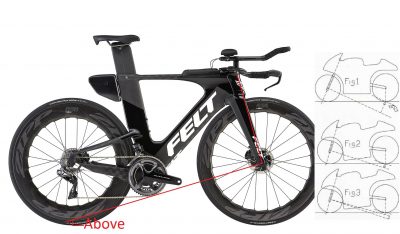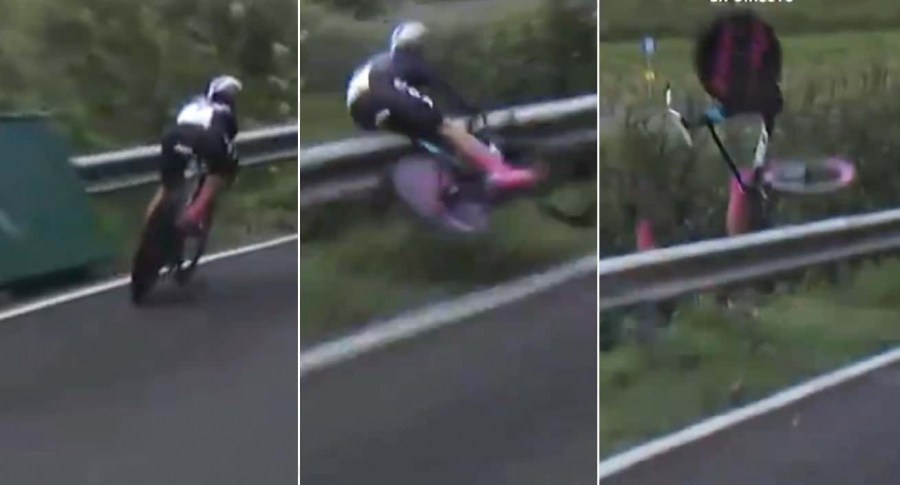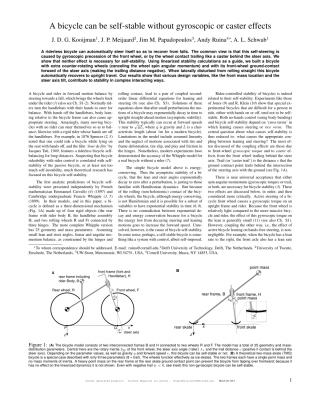Here’s another from the message vault.
The other day, a guy posts to the bicycle Framebuilder’s group on Facebook. His claims were that he understood the cause of Chloé Dygert’s recent crash during the women’s individual time trial at the 2020 UCI Road World Championships in Imola, Italy. It was a very gnarly crash as she is seen losing control of her bike, eventually running out of road and slamming into and flipping over a guardrail and lacerating her knee in the process. The stuff of nightmares.
Obviously, the cause of the loss of control would be on everybody’s mind. Time trial bikes are not designed to handle well and this was a high speed corner where an unstable bike could become an issue. Leonard Zinn wrote specifically on this in Velonews. He looks at it from several perspectives.
I’m not writing about the crash. There’s a lot to what happens to produce a crash and others have tried that at length. I’m writing about what Robert Rae was doing to explain it. The post and one of his comments follow.
Facebook Post by Robert Rae in Framebuilders Group
https://www.facebook.com/groups/Framebuilders/permalink/2034407690028816/
Oct 3, 2020, 7:01 AM
Chloé Dygert’s infamous crash was due to a design fault with her bike. A secondary line of influence from the gyroscopic precession with the front wheel has to below the road surface at the contact point with the rear wheel to secure the rear wheel to the road. Here it is not…
[Photo features the original diagram of this.]
 Facebook Comment by Robert Rae in Framebuilders Group
Facebook Comment by Robert Rae in Framebuilders Group
Oct 3, 2020, 8:56 AM
Gyroscopic precession operates at 90 degrees to an axis of tilt or turning on a spinning wheel, so naturally a secondary line of tilt can be projected out at 90 degrees from the steering axis from the axle of the front wheel – here the red line shown for the steering axis has been brought forward, in parallel, slightly solely to demonstrate this better but the two red lines remain perpendicular. At the rear wheel this secondary projected line must be below the road surface to secure the bike to the road otherwise if it above this has the potential to lift the rear wheel off of the road with a sudden turn of the steering, as like what happened with Dygert. This being the missing theory in bike dynamics devised about 30 years ago that has never been proven wrong to date and is applied to all bikes that travel at speed. When the instability happens, she comes off of the seat removing mass from the rear wheel when the opposite could counteract this, i.e by moving her body position rearwards, and, with the bike about a half meter from the edge of the road surface you can see by the shadow the rear wheel is not secured to the road.
I’m always interested in understanding singletrack chassis design so I read this with interest. I hadn’t seen this theory before. I’ve read Foale, Cossalter, Cocco, and others. With Rae claiming this theory to be his, 30-year old invention but no mention of it in the works of others, I had a whiff of a rat.
The problem, there was a big red flag in his theory (as claimed). He is using the front hub axle as a geometry point. To the casual reader, this would make sense. The problem is that once you dig deeper into singletrack geometry and chassis design, you find that the front hub axle almost always resolves from the analysis. Take mechanical trail and flop, once we work out the details, the front hub axle disappears. This isn’t advanced stuff but it becomes clear to the designer that the front hub axle isn’t a ‘thing’.
So, I messaged him to find out more about this theory. He replied a bit, but ghosted when I asked about further explanation in a publication, or anything, that would fully describe what he claimed. Nothing was produced or shared. He has a website where he makes a similar claim, but that still doesn’t have a full explanation.
Another red flag on this, when I mention rear wheel trail in my message, he seemed to not understand what I was referring to. That’s like not knowing what is meant by ‘wheelbase’. It would be pretty hard to come up with an advanced dynamics design principle if he didn’t really understand basic layout dimensions. Strange.
This guy is a great example of the ‘crackhead inventor’. I’ve experienced plenty of crackhead inventors over the years. Many people claim that I’m one. These are people that come up with some kind of ‘neat’ idea and pursue it regardless of evidence or proof to the contrary. They need to have the “missing theory” that nobody else can see. It makes them special in a world where they are not. I totally get this temptation but an important part of learning is changing your system when you find out that you are wrong. The crackhead inventor just ignores that.
Here’s a related story. When I was young, I was a skate rat in the Boston area. Myself and others would meet up in Harvard Square in Cambridge and head out to the skate spots. One day while we were hanging out watching people go by, this oddball old guy was riding an old english 3-speed through the traffic in an erratic and dangerous fashion and then past us. Not ripping, looking more like an accident waiting to happen. Clumsy and wandering, it looked like he would just tip over at any time. We were just sitting and watching. A guy around us said, “That guy there, he’s a professor at MIT. He teaches about bicycles.” Whether this was true or not, it stuck in my mind. Often, people who claim to be experts may actually be very disconnected from what they are experts on. This old guy may or may not have been an expert on the theories behind bicycle design. What was clear, he barely knew how to ride one or how it interacted with the world.
Peter Verdone
Oct 9, 2020, 8:21 AM
Gyroscopic precession effects on rear wheel.
RE: https://www.facebook.com/photo.php?fbid=2885189758433935
I saw your post on the rear wheel effects of gyroscopic precession on the rear wheel.
The graphic is quite odd as typically this would show rear wheel trail. Instead, this shows a perpendicular line through the axle to an imaginary point. I’m wondering where you got this theory and image?
https://www.facebook.com/groups/Framebuilders/permalink/2034407690028816/
Robert Rae
Oct 10, 2020, 9:13 AM
I am not sure with what you mean by rear wheel trail. I devised the theory about 30 years ago it has never been proven wrong to date and verified by experts in the field.
Peter Verdone
Oct 10, 2020, 9:16 AM
So this is all yours? It just doesn’t make sense to use front hub as a location as any forces would be going from either the contact patch or the steering axis, thus, It would seem that RWT or wheelbase would be in the mix
Peter Verdone
Oct 10, 2020, 9:16 AM
Front axle is resolved out in any geometry I’ve looked at.
Peter Verdone
Oct 10, 2020, 9:17 AM
Certainly, mechanical trail is at the heart of this and front axle doesn’t exist in that lever.
Robert Rae
Oct 10, 2020, 9:19 AM
You need to fully understand gyroscopic precession to understand this.
Peter Verdone
Oct 10, 2020, 9:20 AM
I admit to not be the world’s greatest expert in procession but I do understand bike geometry and axles very rarely come up when drawing the system. That’s why your’s stands out.
Peter Verdone
Oct 10, 2020, 9:21 AM
The gyro introduces a moment to the axis. We don’t need the hub axle if we know what that is.
Peter Verdone
Oct 10, 2020, 9:22 AM
Where is your paper published on all of this?
Peter Verdone
Oct 10, 2020, 9:35 AM
?
That folks, is what we call a bail. When somebody is a fool, they prove it. Be careful of this guy. He seems to be posting up in bicycle and motorcycle threads.
While discussing this exchange and related post, Sam Whittingham shared an article that actually takes a scientific approach to a related issue. A Bicycle Can Be Self-Stable Without Gyroscopic or Caster Effects. There is a problem here that we should all focus on. Look at the graphic describing the geometry of the system that the article examines. It’s referring to ground trail, a dimension that isn’t used in chassis analysis. Only uninformed kids in bicycle shops refer to ground trail. We use actual or ‘mechanical trail‘ when looking at a castor system from an engineering perspective. I would ignore the calculations in this article as they must be erroneous.
Even real scientists get this stuff wrong and listen to uninformed people. Never assume that ‘experts‘ know what they are talking about.


